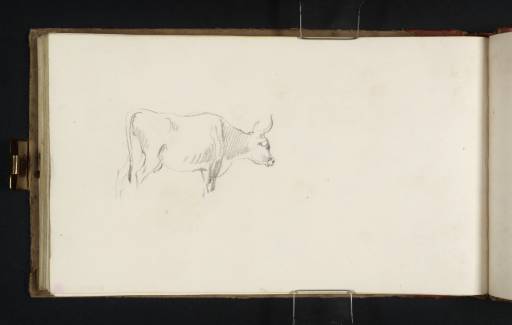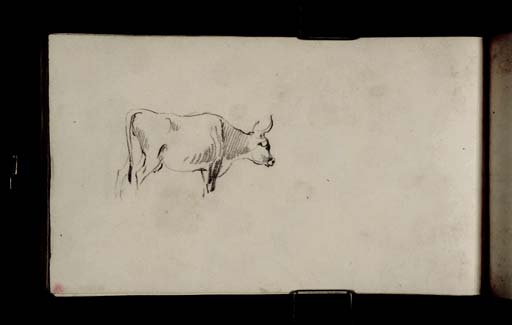Joseph Mallord William Turner A Cow 1819
Image 1 of 2
Joseph Mallord William Turner,
A Cow
1819
Joseph Mallord William Turner 1775–1851
Folio 84 Verso:
A Cow 1819
D14818
Turner Bequest CLXXVII 84 a
Turner Bequest CLXXVII 84 a
Pencil on white wove paper, 110 x 186 mm
Accepted by the nation as part of the Turner Bequest 1856
References
1909
A.J. Finberg, A Complete Inventory of the Drawings of the Turner Bequest, London 1909, vol.I, p.523, as ‘A cow’.
This sketch of a cow, probably seen on the road through the campagna north of Rome, appears to be the only drawing representing the leg of Turner’s journey between Nepi and his first view of the Eternal City, a stretch of over seventeen miles. The lack of topographical sketches is consistent with the desolate nature of the countryside, frequently described by travel writers during the nineteenth century. According to Octavian Blewitt’s A Handbook for Travellers in Central Italy 1850, the road after Nepi ‘loses its picturesque character and enters on bare volcanic country’ which lasts until the final stages of the route to Rome.1 John Chetwode Eustace, meanwhile provided a fuller record in A Classical Tour Through Italy, first published in 1813:
beyond Nepi, or rather beyond Monte Rosi the next stage, the Campagnà di Roma begins to expand its dreary solitudes; and naked hills, and swampy plains rise, and sink by turns, without presenting a single object worth attention. It must not, however, be supposed, that no vegetation decorates these dreary wilds. On the contrary, verdure but seldom interrupted, occasional corn fields, and numerous herds and flocks communicate some degree of animation to these regions otherwise so desolate: but descending from high mountains, the natural seat of barrenness, where, still we witnessed rural beauty and high cultivation, to a plain in the neighbourhood of a populous city, where we might naturally expect, the perfection of gardening and all the bustle of life, we were struck with the wide waste that spreads around, and wondered what might be the cause that deprived so extensive a tract of its inhabitants.2
The flat, arid appearance of the landscape would have been in marked contrast to the building excitement of the traveller as he approached his first sight of Rome from the heights above Baccano or beyond, see folio 85 verso (D14820).
As Ian Warrell has discussed, studies of cows appear frequently amongst Turner’s sketches, particularly within the earlier sketchbooks, reflecting his interest in pastoral landscape and the work of Claude Lorrain and Aelbert Cuyp.3
Nicola Moorby
November 2008
How to cite
Nicola Moorby, ‘A Cow 1819 by Joseph Mallord William Turner’, catalogue entry, November 2008, in David Blayney Brown (ed.), J.M.W. Turner: Sketchbooks, Drawings and Watercolours, Tate Research Publication, December 2012, https://www


